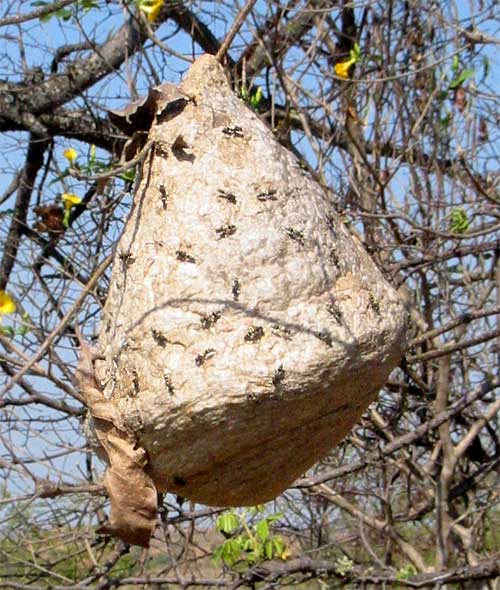Excerpts from Jim Conrad's
Naturalist Newsletter
from the March 31, 2008 Newsletter written in the community of 28 de Junio, in the Central Valley 8 kms west of Pujiltic, elev. ~700m (2300ft), ~N16.331°, ~W92.472°; southeastern Chiapas state, MÉXICO
HORNET NESTS
You see lots of paper wasp nests here, such as the one below.

Not only are such nests commonly seen but also there's a good variety of types, each type being produced by a particular wasp species. Some nests are spherical, others very long, and some quite small. There's one that's just a flat sheet stuck to a tree trunk, with the cells exposed, and these are famed as the most aggressive stingers, sometimes killing people who wander too close.
There's always a discussion as to whether such nests are built by bees or wasps. Structures such as the one in the picture consisting of papery cells surrounded by a leathery paper covering are made by wasps. That's not saying much, though, because the world of wasps is enormous, embracing several wasp families. Species in some families build mud nests but members of the vast Paper or Vespid Wasp Family mostly build nests of plant fiber chewed until it forms paper. Yellowjackets and hornets are members of the Paper Wasp Family. I provide a nice breakdown of the most common wasp types, and a detailed look at one paper-wasp's lifecycle, at www.backyardnature.net/wasps.htm.
Each time I see a hornet-type nest I remember how frequently I used to see them as a kid in Kentucky back in the 50s and 60s, but now they're very rare. I've always assumed it was pesticides that did them in, but here we live in a soup of agricultural chemicals. Here the chemicals are new on the scene, however, so maybe in a few years Chiapas's big paper-wasp nests also will disappear.